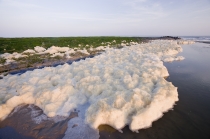What is eutrophication?
Eutrophication occurs when too many nutrients - such as phosphates and nitrates - end up in the environment as a result of human activities. Primarily, the algae (weeds) in the rivers, lakes and oceans benefit from this supply but an excess of nutrients may result in abnormally large algal blooms. Due to this high amount of algae, there is less light in the water and the plants located deeper die out. Due to the decomposition of dead plants, there is less oxygen available. This may ultimately lead to the death of fish and food scarcity for birds.

Large algal blooms - Misjel Decleer
Origin of these substances
These nutrients originate from the agriculture, the industry and the sewage treatment plants. Among other things, the phosphates and nitrates end up in the North Sea via the rivers. Since the 90s however, a decrease in the supply of phosphates has been observed thanks to, among other factors, through the use of phosphate-free laundry detergents.
Approach
The problem of eutrophication of the marine environment is mainly addressed by the implementation of the Marine Strategy Framework Directive and the Water Framework Directive; action programmes are formulated and monitored in collaboration with the OSPAR countries. The Regions themselves take effective measures to combat the eutrophication on the land and the river basins.
This problem is on the agenda of various international fora such as the OSPAR Convention, the Convention and the Protocol of London, the Biodiversity Convention, and the "Regular Process". The Marine Environment service ensures that the Belgian standpoints are in harmony with each other in these different fora.







